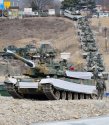Jura The idiot
General
Wednesday at 8:01 AM
now US Pressing for Quick Activation of THAAD in South KoreaMar 8, 2017
and (dated April 25, 2017) US sets up missile defense in South Korea as North shows power
source is DefenseTechThe THAAD anti-missile system could be up and running in South Korea within days despite local protests, the uncertain outcome of South Korea’s presidential election, and renewed warnings from China, according to Adm. Harry Harris.
Harris, commander of U.S Pacific Command, told the House Armed Services Committee Wednesday that the Terminal High Altitude Area Defense system would be “operational in the coming days to be able to better defend South Korea against the growing North Korea threat.”
He said the hit-to-kill THAAD system of missile launchers and powerful X-band radars was designed to bring North Korean leader Kim Jong-un “to his senses, not to his knees.”
The U.S. began moving launchers and other equipment onto a former golf course about 135 miles southeast of Seoul in Seongju province on Wednesday despite one of the periodic protests against the placement by local residents, who fear that having THAAD in the area would make them a likely target for North Korean missiles.
South Korean officials had previously said that THAAD might not be activated before the end of 2017, according to South Korea’s Yonhap news agency, and Harris’ optimistic timeline suggested that the U.S. wanted THAAD in place before the May 5 presidential election in South Korea.
Current frontrunner Moon Jae-in of the Democratic Party, believed to favor a softer line on North Korea, has said that he would review the decision to allow the THAAD placement in Seongju.
However, Moon said in a debate Thursday that “If North Korea carries out a sixth nuclear test, cross-border dialogue will be impossible for a time, and given the single, five-year term (of a president), it will effectively be difficult to improve inter-Korean ties under the next administration.”
China has vehemently opposed having the THAAD system in South Korea since negotiations on its placement began in February 2016.
On Wednesday, Chinese Foreign Ministry spokesperson Geng Shuang renewed Beijing’s “grave concerns” that THAAD could upset the balance of power in the region.
THAAD “will break the strategic balance in the region and further escalate the tensions on the Korean peninsula,” Geng said. “It does no good to the goal of denuclearization of the peninsula and regional peace and stability, and runs counter to the efforts of various parties to resolve the issue through dialogue and consultation,” Geng said.







